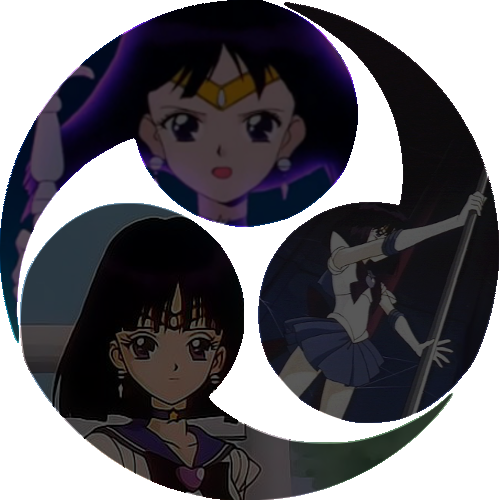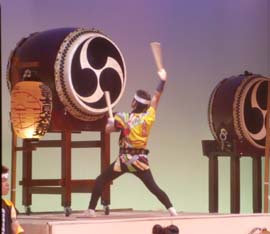It would probably be fair to say that the historical connections and meanings behind the names of the Sailor Moon cast seems to be something of a running theme for me. On the other side of the coin, though, Ms. Takeuchi definitely seems to have done her homework when it comes to naming her characters and even went out of her way to add hidden references to the character’s planets and personalities. And that’s not even talking about all of the in-jokes and references that the anime staff put in!
As most any Sailor Moon fan can tell you, all of the Sailor Soldiers are named in a way that directly references their planets (though the Minako/Venus connection isn’t so obvious). Once she reached the Outer Soldiers, in fact, their names literally come from the Japanese names for their respective planets,1 with the final character for star/planetary-body (星; hoshi)2 omitted. However, oddly enough, Hotaru’s last name, Tomoe, doesn’t fit so neatly into this naming system. In fact, other than the fact that the To part of her name is made up of the symbol for soil (土; tsuchi/to),3 which is the Japanese elemental symbol representing Saturn.4
What about Moe? Well, the kanji used is an alternate (uncommon and used only for names)5 way of writing moe (萌え; infatuation),6 which I’m sure is a term that many modern fans of Japanese anime are familiar with.7 So at first blush, one could assume that Hotaru’s last name implies that she is infatuated with the earth… but that would be incorrect. As with the names of some other characters, the most obvious Japanese translation is not always the correct answer, and that’s also the case here with Hotaru’s last name.
You see, the more likely interpretation is that the kanji which make of Tomoe (土萠) are irrelevant and that her name is actually a direct reference to the Japanese shape known as a tomoe.8 In its most common form, as a mitsudomoe (三つ巴; triple tomoe) which is commonly found on Shinto shrines and on taiko drums, it is said to represent the three-fold division between mankind, earth, and sky. Incidentally, going back to its Shinto roots (though the symbol also appears in Korea, China, and throughout Asia, so it’s fair to say that its origins are not Japanese), the tomoe was traditionally associated with Hachiman, the god of war.9 What’s more, this was also the symbol used on the flag of the Ryukyuan Kingdom10 and is today strongly associated with karate and various other forms of martial arts throughout Okinawa, further cementing its military nature.
Taken all together, it’s pretty apparent that the stronger connection for Hotaru here would be with the tomoe symbol, both for its military applications (which ties in nicely with her status as one of the most powerful Sailor Soldiers) as well as for its symbolism related to the various stages of life – birth, death, and life in heaven.
As usual, I really have to give it to Ms. Takeuchi to be able to slip references like this in, all the while making it seem totally natural. Not only did she manage to include the reference to the planet Saturn, but even managed to include a far deeper cultural reference. She never ceases to amaze!
References:
- Or dwarf planet, in Pluto’s case ↩
- See 星 on jisho.org ↩
- See 土 on jisho.org ↩
- See this presentation outlining Japanese astronomy terms ↩
- See a Japanese write-up on the history of the kanji ↩
- See 萌え on jisho.org ↩
- See Moe (Slang) (Wikipedia) ↩
- See Tomoe (Wikipedia) ↩
- See Hachiman (Wikipedia) ↩
- See Japanese Symbols (Mitsu Domoe) ↩




Hi! I’m enjoying reading your articles very much! ^_^ I’ve recently started watching Sailor Moon and was entirely fascinated by it. Reading your articles, I was very excited to see how a lot there is to discover from BSSM, and how thoroughly you’ve put your love in it!
About this post,
> “…the kanji used is an alternate … way of writing moe (萌え; infatuation),[6] which I’m sure is a term that many modern fans of Japanese anime are familiar with.”
It should be important to point out, that there is a well-known theory that it is entirely the other way around — it is said that the origin of “moe” itself is from Hotaru Tomoe!
The original meaning of the Kanji “萌” itself is the sprouting of plants, or the beginning of events (e.g. http://dictionary.goo.ne.jp/jn/200969/meaning/m0u/). The “infatuation” meaning of “萌” on the other hand, does not have a well-established consensus on its origin, and several theories exist. The first three theories from the Japanese Wikipedia article (https://ja.wikipedia.org/wiki/%E8%90%8C%E3%81%88#.E3.80.8C.E8.90.8C.E3.81.88.E3.80.8D.E3.81.AE.E6.88.90.E7.AB.8B.E3.83.BB.E6.99.AE.E5.8F.8A) are:
– It originates in around 1990 from a misconversion (mistyping) of “燃え燃え” — “燃” means to burn (your heart, in this case)
– It is from Moe from the 1993 anime “Kyoryu Wakusei”
– It is from Hotaru Tomoe’s name (1994), inspired by Hotaru’s fragile personality and appearance (e.g. https://books.google.co.jp/books?id=6DnRAgAAQBAJ&pg=PT245 , etc.)
So it’s not certain if the author was aware of this definition of “萌.” So I do agree that
> “You see, the more likely interpretation is that the kanji which make of Tomoe (土萠) are irrelevant…”
Anyway, it’s interesting to point out that a well-known theory states that Hotaru’s name may have been the origin of the icon of Japanese subculture… and although it’s uncertain, it would be so cool if Hotaru (and ultimately, the Sailor Moon series) actually was one of the foundations of such a large movement! (It’s cool anyway, that Hotaru is *said* to be the origin!)
I enjoy your theory. Yes, I believe the double meanings particularly the “growth” definition. Saturn is aligned to harvest, signified by her scythe (turned glaive). Birth, growth, death, then rebirth and the cycle continues over and over. Especially aligned to 土 which means Earth/soil and association with agriculture.
So interesting! It also ties in to Hotaru embodying three separate personas: Hotaru, Sailor Saturn, and Mistress 9.